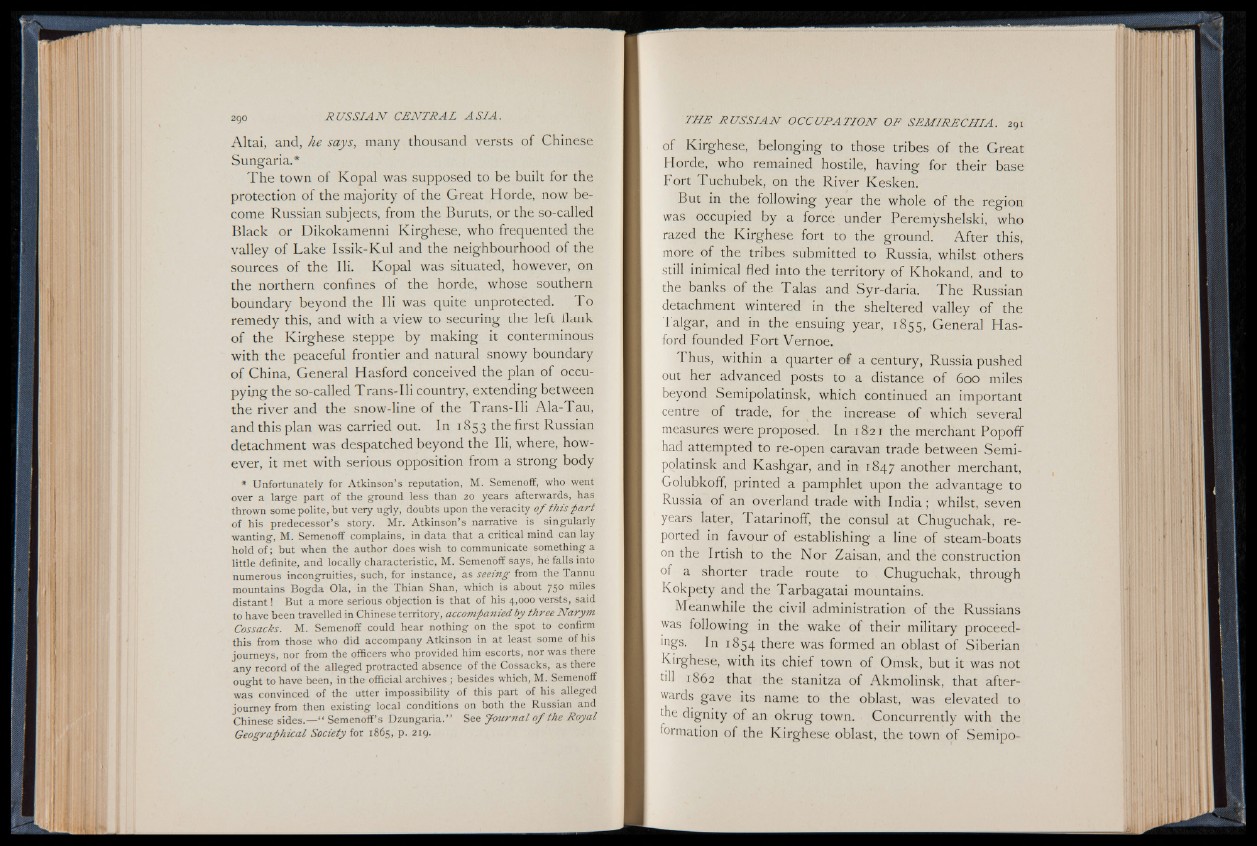
Altai, and, he says, many thousand versts of Chinese
Sungaria.*
The town of Kopal was supposed to be built for the
protection of the majority of the Great Horde, now become
Russian subjects, from the Buruts, or the so-called
Black or Dikokamenni Kirghese, who frequented the
valley of Lake Issik-Kul and the neighbourhood of the
sources of the Ili. Kopal was situated, however, on
the northern confines of the horde, whose southern
boundary beyond the Ili was quite unprotected. To
remedy this, and with a view to securing the left flank
of the Kirghese steppe by making it conterminous
with the peaceful frontier and natural snowy boundary
of China, General Hasford conceived the plan of occupying
the so-called Trans-Ili country, extending between
the river and the snow-line of the Trans-Ili Ala-Tau,
and this plan was carried out. In 1853 the first Russian
detachment was despatched beyond the Ili, where, however,
it met with serious opposition from a strong body
* Unfortunately for Atkinson’ s reputation, M. Semenoff, who went
over a large part of the ground less than 20 years afterwards, has
thrown some polite, but very ugly, doubts upon the veracity o f this fa r t
of his predecessor’ s story. Mr. Atkinson’ s narrative is singularly
wanting, M. Semenoff complains, in data that a critical mind can lay
hold o f ; but when the author does wish to communicate something a
little definite, and locally characteristic, M. Semenoff says, he falls into
numerous incongruities, such, for instance, as seeing from the Tannu
mountains Bogda Ola, in the Thian Shan, which is about 750 miles
dis tan t! But a more serious objection is that of his 4,000 versts, said
to have been travelled in Chinese territory, accompanied by three Naryrn
Cossacks. M. Semenoff could hear nothing on the spot to confirm
this from those who did accompany Atkinson in at least some of his
journeys, nor from the officers who provided him escorts, nor was there
any record of the alleged protracted absence of the Cossacks, as there
ought to have been, in the official archives ; besides which, M. Semenoff
was convinced of the utter impossibility of this part of his alleged
journey from then existing local conditions on both the Russian and
Chinese sides.— “ Semenoff’ s Dzungaria.” See Journal o f the Royal
Geographical Society for 1865, p. 219.
of Kirghese, belonging to those tribes of the Great
Horde, who remained hostile, having for their base
Fort Tuchubek, on the River Kesken.
But in the following year the whole of the region
was occupied by a force under Peremyshelski, who
razed the Kirghese fort to the ground. After this,
more of the tribes submitted to Russia, whilst others
still inimical fled into the territory of Khokand, and to
the banks of the Talas and Syr-daria. The Russian
detachment wintered in the sheltered valley of the
Talgar, and in the ensuing year, 1855, General Hasford
founded Fort Vernoe.
Thus, within a quarter of a century, Russia pushed
out her advanced posts to a distance of 600 miles
beyond Semipolatinsk, which continued an important
centre of trade, for the increase of which several
measures were proposed. In 1821 the merchant PopofT
had attempted to re-open caravan trade between Semipolatinsk
and Kashgar, and in 1847 another merchant,
Golubkoff, printed a pamphlet upon the advantage to
Russia of an overland trade with India; whilst, seven
years later, Tatarinoff, the consul at Chuguchak, reported
in favour of establishing a line of steam-boats
on the Irtish to the Nor Zaisan, and the construction
of a shorter trade route to Chuguchak, through
Kokpety and the Tarbagatai mountains.
JVTeanwhile the civil administration of the Russians
was following in the wake of their military proceedings.
In 1854 there was formed an oblast of Siberian
Kirghese, with its chief town of Omsk, but it was not
fill 1862 that the stanitza of Akmolinsk, that afterwards
gave its name to the oblast, was elevated to
the dignity of an okrug town. Concurrently with the
formation of the Kirghese oblast, the town of Semipo